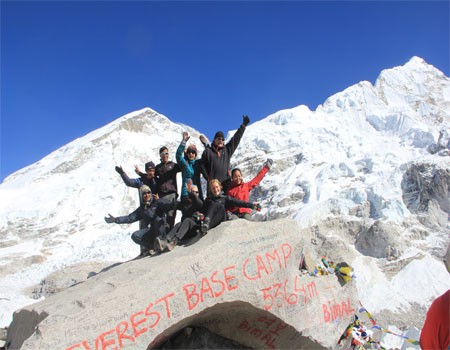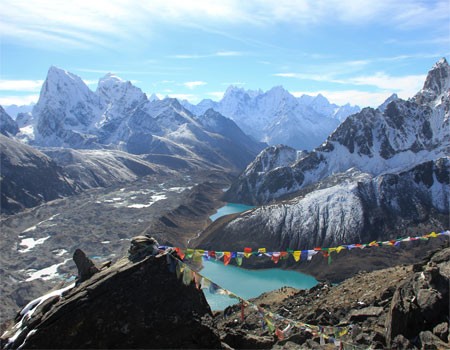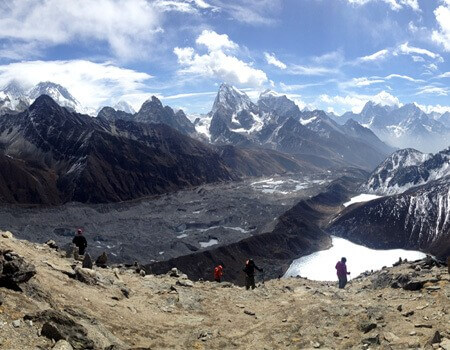The Everest Base Camp Helicopter Return Trek is the shortest trekking itinerary that takes you to the bottom of the world's highest mountain and provides a scenic chopper flight and an adventure high-altitude walk experience at the same time.
This trip begins with a regularly scheduled air journey on a small plane to Lukla airport and ends with a scenic Heli Return flight to Kathmandu after you visit the base camp and Kala Patthar. Following the significant itinerary of the EBC, after landing at Tenzing-Hilary Airport, you walk to Phakding on the first day. After a one-night stay in Phakding, you visit Namche Bazaar on the second day, take one extra day for acclimatization, and hike to Hotel Everest View.
On the fourth day, you reach Tengboche, toward the Khumbu Valley. After Tengboche:
- Trek to Dingboche.
- Take the second altitude practice rest day during this trip in the Khumbu Region.
- Hike to Nangkartshang Hill.
Now, you Go ahead to Lobuche on the 7th and Gorakshep on the 8th. From Gorakshep, you Hike to the Base Camp of the world's tallest mountain. The 9th day is the last day of the Helicopter-Back EBC Trek, so you hike to Kala Patthar (5550m) from Gorakshep and then fly out to Kathmandu directly after breakfast.
Why Do We Recommend Helicopter Return Trek from Everest Base Camp?

Helicopter flying above mountains on Everest Base Camp Helicopter Return Trek.
The Helicopter Return Trek from Everest Base Camp is recommended for time-bounded travelers who do not have enough days to complete the regular 12-day trip or do not want to hike back the same way after visiting the base camp. It offers the best combination of a walking and scenic flight experience above the high mountains in the Everest Region, Nepal.
The 'Everest Base Camp Heli Back Trek' provides two different experiences. An adventure of walking at high elevation and a thrilling Helicopter Tour as a luxury scenic Heli-ride back to Kathmandu directly from the mountain
Trekking to Everest Base Camp in Nepal offers a fantastic mountain adventure. Along the way, you will see breathtaking views of magnificent snow-capped mountains, beautiful valleys, captivating landscapes, and other natural attractions. The warm hospitality of the locals in the region will give you extra emotional feelings and attachments you may never forget.
Experiencing an adventurous walk on the classical Everest Base Camp trail from Lukla and a helicopter return directly down to Kathmandu from the mountain gives you both adventure and luxury experiences from this trip to Nepal. The regular Trek to the foot of the world's highest mountain takes eight days from Kathmandu, including two acclimatization rest days in Namche and Dingboche. Then, it returns to Lukla after three long days of walking. The traditional Base Camp Trekking itinerary is a 12-day round trip. If you do not want to use the same way back to Lukla or are not interested in walking those three long treks around, flying out on a Helicopter from Everest is the best trekking package for you.
The time-bound trekker may need help completing the usual itinerary. We present a quick Trekking package to explore this mountain region by walking to the bottom of Everest and flying out on a helicopter. After taking off from Gorakshep on an aircraft, you may drop off either in Lukla or Kathmandu, depending on your time and interest.
Trekking to Everest Base Camp and flying back by Helicopter offers an exceptional experience for the regular EBC trekkers because the trekkers, following a usual Trekking itinerary, never get the opportunity to experience the luxury Helicopter Ride in the Himalayas.
Helicopter Return from Everest Base Camp is The Quickest and Luxurious Option
The Everest Base Camp Trek Return by Helicopter is Khumbu's quickest and most luxurious mountain journey. In a few days, you can explore this great Himalayan Region. Helicopter Return trek is the best trekking package for a short holiday in Nepal, allowing you to reach the foot of the world's tallest mountain and see it from the nearest distance.
The Heli Return Everest Base Camp Trek also saves time, and you can explore the other beautiful historical places in the country. If you save days doing this fly-back EBC trek, you can go on a jungle safari, do a day tour in Kathmandu, and visit the beautiful lake city of Pokhara.
This Heli Return Trek is designed for those who love to experience adventure and thrilling flight in the Nepalese Himalayas. You feel the different experience of flying above the high mountains, which you see amazingly standing on the way to Base Camp. So, the views you see from land and by Helicopter provide a different experience from this Helicopter Return trek.
Book Everest Base Camp Trek Return by Helicopter with Frolic Adventure
Frolic Adventure operates the Everest Base Camp Trek Return by Helicopter. Our main goal is customer satisfaction, so we offer the best price and service. We arrange for experienced, informative guides and friendly helpers on the tour. We have a special offer for this EBC Heli Return Trek for group trekkers. You can easily book this fly-back Trek through the online payment link or contact us if you book the trip in a group with additional services other than the package.


























